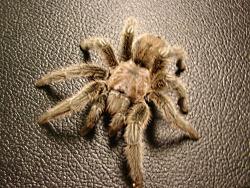
at Stokes Nature Center
Courtesy & Copyright 2010
Andrea Liberatore
 Aphonopelma iodius
Aphonopelma iodius
Courtesy & Copyright 2003
James Pitts
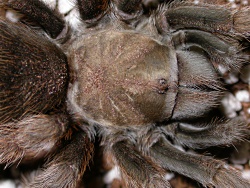 Aphonopelma iodius
Aphonopelma iodius
Courtesy & Copyright 2003
James Pitts
 Burrow of Aphonopelma iodius
Burrow of Aphonopelma iodius
Courtesy & Copyright 2004
James Pitts
 Burrow of Aphonopelma iodius
Burrow of Aphonopelma iodius
Courtesy & Copyright 2004
James Pitts
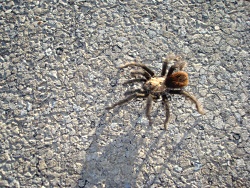 Tarantula crossing the road, Eagle Mountain, UT, click to view larger image, Photo Courtesy & Copyright 2010 Shawna Olsen
Tarantula crossing the road, Eagle Mountain, UT, click to view larger image, Photo Courtesy & Copyright 2010 Shawna Olsen
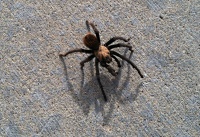
Tarantula on a parking lot
University of Utah
20 August 2013
Salt Lake City, UT
Click to view larger image,
Courtesy & Copyright 2013
Lily Marsden
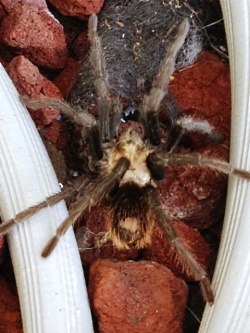 Tarantula on the East Bench, Ogden, UT, click to view larger image, Photo Courtesy & Copyright 2013 Lauren Fowler
Tarantula on the East Bench, Ogden, UT, click to view larger image, Photo Courtesy & Copyright 2013 Lauren Fowler
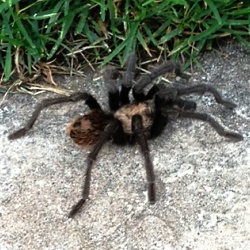 Tarantula on the East Bench, Ogden, UT, click to view larger image, Photo Courtesy & Copyright 2013 Lauren Fowler
Tarantula on the East Bench, Ogden, UT, click to view larger image, Photo Courtesy & Copyright 2013 Lauren Fowler
Hi, I’m Holly Strand from Stokes Nature Center in beautiful Logan Canyon.
Here at the Nature Center, we have an 8 legged staff member named Harrietta. She is a beautiful Chilean Rose Tarantula. Visitors to the Nature Center often exclaim. “Wow! I’m glad those things don’t live around here!” But they are wrong. Tarantulas DO live here as well as in most areas of Utah.
Depending on your source of information Utah is home to either three or four different tarantula species. They’ve been found in the Mojave region in southwestern Utah as well as in the Great Basin.
For a number of reasons few people actually see the tarantulas in the Utah wilds. First of all, Utah is in the far northern part of the tarantula’s distribution range. This means environmental conditions here are less optimal for the spiders than in locations to the south. Secondly, both males and females spend most of their life in and around their burrows, which are dug into the ground in sparsely vegetated areas. As ambush predators, tarantulas lie motionless at the burrow entrance, waiting for an unsuspecting cricket, centipede or even a mouse to wander by. Only then will they dash out of their burrow to bite their victim and pull it back to the safety of their home for feeding. Lastly, tarantulas are nocturnal creatures, venturing out only after most humans have gone inside for the night.
Your best chance to see a tarantula is in the fall. During the months of September and October, mature males roam away from their burrows in search of a female counterpart. In SW Utah large numbers of males can sometimes be seen wandering in search of tarantula love.
In spite of their fearsome appearance, tarantulas are harmless to humans and large pets (e.g., dogs and cats). Their venom is of no medical significance, and, nobody has ever died from such a bite. Most people compare the bite to that of a bee sting and experience no lasting ill-effects other than mild to moderate pain and slight swelling at the site of the bite.
Special thanks to Andrea Liberatore of Stokes Nature Center and Dr. James Pitts of Utah State University’s Dept of Biology for their help with this Wild About Utah topic.
For sources and pictures go to www.wildaboututah.org.
For Wild About Utah and Stokes Nature Center, I’m Holly Strand.
Credits:
Images: Courtesy & Copyright 2010 Andrea Liberatore Stokes Nature Center
Courtesy & Copyright 2010 Shawna Olsen
Courtesy & Copyright 2013 Lily Marsden
Courtesy & Copyright 2013 Lauren Fowler
Text: Andrea Liberatore & Holly Strand,
Stokes Nature Center
Sources & Additional Reading
Allred, Dorald M., B. J. Kaston. 1983. A list of Utah spiders, with their localities. Western North American Naturalist, Vol 43, No 3 https://ojs.lib.byu.edu/ojs/index.php/wnan
/article/view/2591/2938
Hendrixson, Brett. “So You Found A Tarantula” . American Tarantula Society Headquarters. https://atshq.org/articles/found.html [Accessed July 22, 2010]
Prentice, Thomas R. 1997. Theraphosidae of the Mojave Desert West and North of the Colorado River (Araneae, Mygalomorphae, Theraphosideae) The Journal of Arachnology 25:137–176 https://www.americanarachnology.org/JoA_free
/JoA_v25_n2/JoA_v25_p137.pdf [Accessed July 22, 2010]
Sharp, Jay. “About Tarantulas” Desert USA https://www.desertusa.com/july96/du_taran.html [Accessed July 22, 2010]
